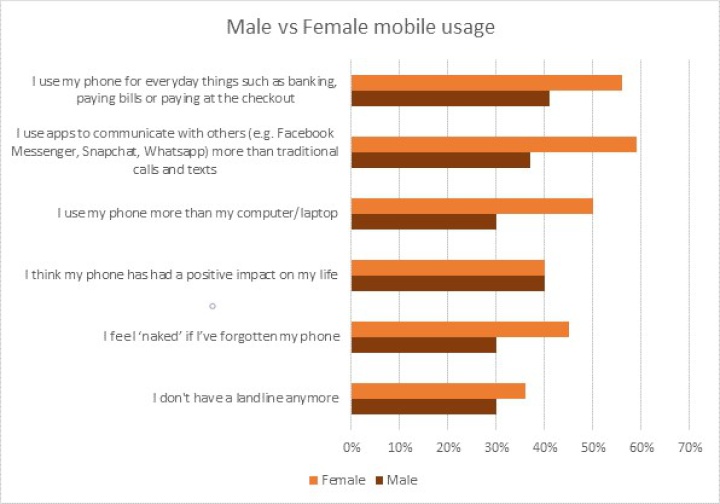Are women the masters of mobiles?
Are women the masters of
mobiles?
Auckland,
20 April 2018. The old stereotype of women relying on their
phones more than men may ring true if the latest Canstar
Blue data is anything to go by.
The latest survey of 4,643 Kiwis reveals that 45% of woman admit to feeling ‘naked’ if they forget their phone and a huge 50% say they now use their phone more than their laptop or computer. This compares to 30%, respectively, for men.
Canstar’s Emma Quantrill comments:
“There will be
a lot of husbands and partners raising their eyes to the sky
at this news! But, once we get over the ‘tell us
something we don’t know’, it’s actually interesting to
see that it’s been women, more than men, who have embraced
the changes in the way we communicate and how we use the
devices we carry around in our pockets and
bags.”
How do men and
women compare?
The following graph indicates the
differences in male and female mobile phone usage and
habits:

From making a call to managing your
life
Mobile phones have been around for decades
with the first one used in the USA in 1973. Globally,
commercial networks began to rollout in 1979 with New
Zealand launching its first one in 1987. Back then, you
could expect to pay in the region of $6,000 for a handset
and it you wanted to get on the network, you may well have
had to put your name on the waiting list. But we’ve come
a long way in the last 30 years and the handsets, as well as
the way we use them, has changed beyond early
comprehension.
According to the latest Commerce
Commission data, there are now in excess of 6.4 million
mobile connections in New Zealand and we are making more
voice calls than ever before. In contrast, as apps such as
Facebook Messenger and WhatsApp become commonplace, SMS or
‘text’ messages, have declined by around 50% since their
height of popularity in 2012.
Quantrill
continues:
“Digital innovation and rapid acceptance and
growth of social media have contributed to changes in the
way we communicate and the kind of telecom services we pay
for. We want video and pictures as well as words but we
also expect the device that delivers all of this to act as a
wallet, document retention centre, gateway to our bank and
much more. In addition, we want high quality and we want it
quickly and cheaply.
Most Satisfied
Customers – Prepaid and SIM
The flexibility
that pre-paid offers is an attractive option for a lot of
mobile phone customers. In fact, close to three quarters of
the people Canstar Blue surveyed were on pre-pay. However,
where flexibility is important and may be the motivation for
the type of mobile plan someone chooses, Canstar Blue
research shows that when it comes to choosing a provider,
value for money and customer service are the biggest drivers
of satisfaction for consumers. This year, for the fourth
year running, we a delighted to announce Skinny as the
recipients
of our Prepaid and SIM
Overall Customer Satisfaction Award for 2018.
Accepting the award on behalf of Skinny, brand manager
Ally Young said:
“We are truly proud to be consistently
winning this customer satisfaction award year on year. Each
Canstar Blue Award that we win reinforces the effort that
our team puts in daily to deliver a commitment of keeping
our prices low and our customers happy. Plus, it’s nice to
win additional categories this year, as this shows that we
are continuing to outperform for our customers in other
areas as well.”
Most
Satisfied Customers – Contracted Plan
For
consumers who prefer the certainty of a contracted
plan with a device, 2Degrees takes the honour of
the 2018 Customer Satisfaction Award, Contracted Plan.
On behalf of 2degrees, Chief marketing officer Roy Ong
said the team was chuffed to receive the award:
“We
have a proud tradition of innovation at 2degrees. We
recently launched WiFi Calling, so customers in areas that
don’t have great mobile coverage can call and text without
missing a beat. 2degrees has its own national mobile
network and provides coverage to 98.5% of the places
Kiwi’s live and work, but like all networks there can be
coverage challenges at times. Wifi Calling can help address
that. It’s also a great option for customers roaming
overseas – travellers can use WiFi networks as a safe,
cost effective option.”


 Watercare: Watercare Gets To Work On First Permanent Non-Potable Water Tanker Filling Station In Māngere
Watercare: Watercare Gets To Work On First Permanent Non-Potable Water Tanker Filling Station In Māngere Alcohol Healthwatch: Licensing Decision Lauded For Prohibiting Buy Now Pay Later Schemes In Bottle Stores
Alcohol Healthwatch: Licensing Decision Lauded For Prohibiting Buy Now Pay Later Schemes In Bottle Stores Motor Industry Association: Vehicle Registrations Up 5.6% In December, But Year-To-Date Sales Reflect Market Challenges
Motor Industry Association: Vehicle Registrations Up 5.6% In December, But Year-To-Date Sales Reflect Market Challenges BNZ: Depression-era Bequest Still Helping 88 Years Later
BNZ: Depression-era Bequest Still Helping 88 Years Later Hugh Grant: How Can Telehealth And Home Healthcare Solutions Be Helpful?
Hugh Grant: How Can Telehealth And Home Healthcare Solutions Be Helpful? New Zealand Merino Company: The New Zealand Merino Company Will Investigate PETA Claims
New Zealand Merino Company: The New Zealand Merino Company Will Investigate PETA Claims



